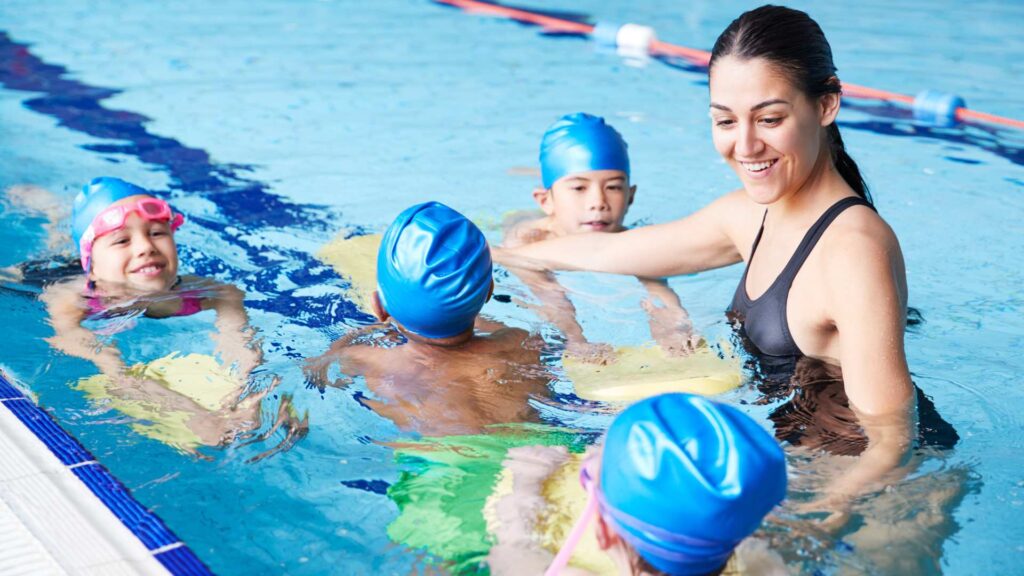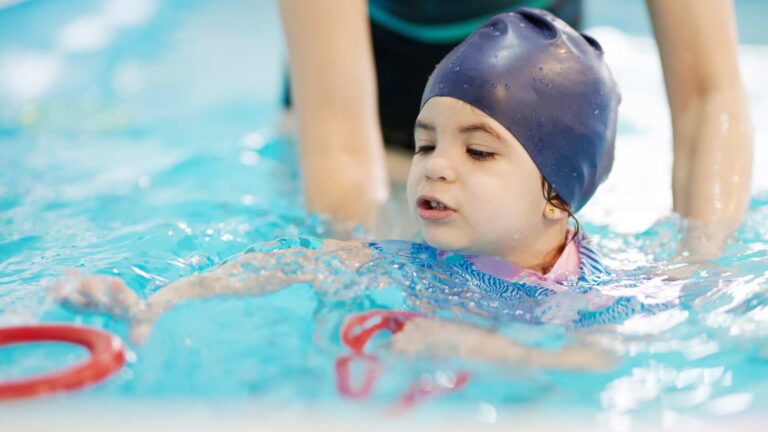Table of Contents
How important is it for children with ASD to learn swimming skills?
Water is a source of joy and relaxation for many, including kids with autism, offering countless opportunities for fun, exercise, and sensory experiences. Swimming, in particular, provides children with a way to build physical strength, improve coordination, and gain confidence. However, alongside these benefits, it is crucial to acknowledge and address the risks that water can pose, particularly to children with autism spectrum disorder (ASD), while promoting water safety skills.
Children with autism perceive the world in a unique way, which often means they may not recognize danger or risks in their surroundings, making them more vulnerable to accidents. Among the most pressing concerns is the risk of drowning, which remains a leading cause of accidental death among children with autism, according to a study by the National Library of Medicine.
For instance, NBC10 Boston recently reported the heartbreaking case of a 4-year-old girl with autism who was found unresponsive in a neighbor’s pool. This devastating loss is a poignant reminder of the importance of safety measures to protect children on the spectrum from unfortunate incidents.
At ABA Centers of Florida, we believe that teaching children how to be safe around water is not just a precaution but a necessary life skill. Let’s look at how together we can promote safety and accident prevention through water safety for individuals with autism spectrum disorder.
Understanding the Risks
Autism encompasses a broad range of symptoms and behaviors, often described as a spectrum. The spectrum in autism means that the severity and nature of autism can vary significantly from one child to another. Some children with autism need constant support, while others may be more independent but still face challenges that put them at risk. The level of support often correlates with the degree of their challenges, including communication difficulties, sensory sensitivities, and understanding abstract concepts like danger.
For instance, a child with severe autism might struggle with essential communication and understanding, requiring continuous supervision to stay safe. Conversely, a child with milder symptoms might appear more independent but could still misinterpret social cues or engage in risky behaviors.
Why Are Children with Autism More Exposed to Risks?

Children with autism face increased risks due to the unique ways they interact with the world. These factors include:
Communication Challenges: Many children with autism have difficulties with verbal and non-verbal communication. They may struggle to express their needs or understand instructions, especially in stressful situations. This difficulty can hinder their ability to ask for help or comprehend warnings about dangerous conditions.
Difficulty Grasping Abstract Concepts: Abstract ideas, like “danger” or “risk,” can be challenging for children with autism to understand. They may not grasp why, for example, running into the street or jumping into the water could be harmful.
Sensory Sensitivities: Children with autism often experience heightened sensory sensitivities. Sounds, lights, textures, and other sensory inputs can either attract or repel them from specific environments, sometimes leading to risky behaviors. For example, the visual appeal of water might draw a child without the child recognizing its dangers.
Dependence on Routines and Unpredictable Reactions: Many children with autism rely on routines. Any disruption can cause anxiety or distress, leading to unpredictable behaviors. In unfamiliar or overstimulating environments, a child might react by running away or engaging in unsafe behaviors.
Challenging Behaviors: Autism is often associated with complex behaviors, such as tantrums, aggression, self-injury, and elopement (wandering away from a safe environment without warning or supervision). This behavior is risky as it can lead to dangerous situations, like running into traffic or drowning. For instance, a study by the Children’s Services Council revealed that between January 1, 2012, and January 2023, 109 children with autism or suspected autism tragically lost their lives due to drowning in Florida.
Water Safety Strategies for Children with ASD: Protecting Your Child in and Around Water
Ensuring water safety for children with autism requires a comprehensive approach that goes beyond the basics. While teaching your child to swim and encouraging them to communicate their needs are crucial steps, additional measures can provide extra layers of protection. Here are some strategies to help safeguard your child around water:
1. Swimming Lessons Tailored to Children with ASD

Teaching children with autism to swim is one of the most effective ways to protect them from water-related accidents. However, traditional swimming lessons may not always meet their unique needs. Look for programs that specialize in teaching children with special needs.
2. Effective Communication Methods
Utilize clear, concise language supported by visual aids such as pictograms or cards, as children with ASD often respond better to visual information. Repetition of instructions is also key to reinforcing learning. Incorporating hands-on activities or role-playing can further help them understand safety concepts while keeping them engaged and attentive.
3. Physical Barriers
Creating physical barriers between your child and potential water hazards adds a critical layer of safety. Consider implementing the following:
- Install alarms on pool gates and doors leading to pool areas. These alarms can alert you immediately if your child enters the pool area unsupervised.
- A sturdy, motorized pool cover can provide an additional layer of protection, making it more difficult for a child to access the water without adult supervision.
- Use high-quality locks on doors and install fencing around pools that are at least four feet high with self-latching gates. Ensure that the latch is out of your child’s reach.
- If your home has windows that provide access to a pool area, install alarms on those windows as well.
Explore more about safety barriers here.
4. Establishing and Teaching Safety Rules
- Teach your child the importance of always having an adult present when near or in the pool. Reinforce this rule regularly through visual reminders and role-playing scenarios.

- Create a clear boundary around the pool and any body of water that your child should not cross without permission.
- Teach your child primary emergency responses, such as floating on their back or calling for help if they find themselves in distress.
5. Collaboration
Your safety efforts should extend beyond your immediate household. Informing neighbors, family, and friends about your child’s needs and the safety measures in place can provide additional layers of protection:
- When visiting others or having guests at your home, share your water safety rules and protocols with them. Make sure they understand the importance of these measures and how to follow them.
- Build a network of neighbors who are aware of your child’s tendencies and who can keep an eye out if they see your child near water unsupervised.
- When hosting gatherings, designate a responsible adult as a “water watcher” whose sole responsibility is to supervise children near water, including pools, ponds, or lakes.
6. Continuous Supervision and Vigilance
Always keep a close watch on your child when they are near water, even if they are in a group or seem confident in their swimming abilities.
The Role of ABA Therapy in Teaching Safety Skills
Applied Behavior Analysis (ABA) offers a structured approach that can be highly effective in teaching safety skills to children with autism. This method focuses on understanding and modifying behavior in a practical and individualized way, making it particularly well-suited to addressing the unique challenges faced by children on the spectrum.
ABA therapy helps by breaking down complex safety behaviors into smaller, manageable steps that are easier for the child to learn and understand. For example, if the goal is to teach a child water safety, an ABA therapist might begin by teaching the child to recognize the boundary of a pool and stop at the edge. The next step could involve practicing how to call for help or what to do if they accidentally fall into the water. The therapist and client practice each step until it becomes second nature to the child.
Another significant benefit of ABA therapy is its focus on positive reinforcement. This approach means that when a child successfully performs a safety-related behavior, they receive praise, encouragement, or a small reward, reinforcing the behavior and making it more likely to be repeated in the future. Over time, this helps the child learn to make safer choices in various situations.
ABA Centers of Florida: Your Partner in Autism Care
At ABA Centers of Florida, we support families in navigating the unique needs of children with autism. Our team provides personalized ABA therapy and resources designed to enhance safety and quality of life. By focusing on individual needs and incorporating effective strategies, we help families create safe and enjoyable experiences for their children.
If you have concerns about your child’s safety around water or if you are seeking additional support, contact us today. Our experts are here to provide guidance and assistance to ensure that your child can safely enjoy all that water activities have to offer.
For more information, please call us at (772) 773-1975 or visit our website to learn more about our services and how we can support your family.








